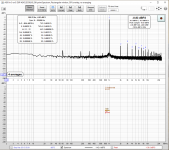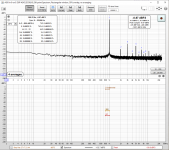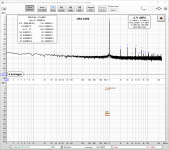The OPA1656 datasheet clearly states that the supply current given is per amplifier (page 6, electrical specifications table). 3.9mA x 2 = 7.8mA typical. Other amplifiers may specify the total of all amplifiers in the package.
The OPA1656 datasheet also clearly states at the top in the product description:
"The OPA1656 operates over a very wide supply range of ±2.25 V to ±18 V or (4.5 V to 36 V) on 3.9 mA of supply current to accommodate the power supply constraints of many types of audio products."
This statement refers to the device, not a single amp within the device. Very misleading... Fortunately even per amp its still a meaningful improvement over the LM4562 @14.4ma measured per device I'm taking out.
And as stated earlier, not really an issue if there are only a few. But lol, when 30 are in a small enclosure that also has a number of other hot running chips, its a problem.
Last edited:
This statement refers to the device, not a single amp within the device. Very misleading... Fortunately even per amp its still a meaningful improvement over the LM4562 @14.4ma measured per device I'm taking out.
The headline on Page 1 of the datasheet is clear and obvious:
Quiescent current: 3.9 mA per channel
I measured 2 of my AK4490 boards with opamp LPF buffer. Board with LM4562 measured 10mA and board with OPA1656 measured 7mA (both at +-15V).
BTW in this particular application I could not measure any difference in THD between LM4562 and OPA1656 either at 1kHz or 20kHz. Probably the DAC or the soundcard ADC (AK5394) is the limiting factor.
The headline on Page 1 of the datasheet is clear and obvious:
Quiescent current: 3.9 mA per channel
Oh I don't disagree now that I look closer...I just got caught up in rushing. I was comparing the TI datasheet for the LM4562 (which is spec'd per package) with the TI datasheet for the OPA1656 (which is not). When I saw the 1656 description, I went with wishful thinking instead of scrutinizing it further.
Note to self: don't do that. lol.
BTW in this particular application I could not measure any difference in THD between LM4562 and OPA1656 either at 1kHz or 20kHz. Probably the DAC or the soundcard ADC (AK5394) is the limiting factor.
Apparently (hopefully) old electrolytics account for the higher distortion levels in mine. Degraded over an order of magnitude since I put the 4562 in it years ago. We'll soon find out, they're both getting full recaps next week.
Has anyone used the OPA1678 (dual-channel) or OPA1679 (quad-channel)? If so, how do they sound and how do they measure in ADC and DAC applications?
They are rated 4.5-nV/√Hz and 0.0001% THD but importantly they are 2 mA per channel (not 5mA).
There exist lower THD and lower noise super opamps but in some heat and current constrained applications I wonder if something like the OPA1678 might be much lower THD than stock and perhaps also better sounding? I am using interfaces that come with NJM2068, NE5532 and TL074 stock. (Digidesign and E-MU.) I did a test, for example, with upgrading a CS4398 DAC from NE5532 to LM4562NA and then OPA2134. The OPA2134 and LM4562NA measured almost identically but both above NE5532. OPA2134 measured the best. Perhaps OPA1678 will also not be the bottle neck and perhaps will measure similarly to OPA2134 or LM4562NA. And I would like to know what people think of the OPA1678 sound signature in DAC filter applications.
I ask since I am in the process of figuring out what to do with the TL074 in the Digidesign 003 rack. The OPA1679 (quad-channel) is one possibility as is the OPA4134. Also my E-MU 1616m is basically a little oven (half rack) with two PCB face to face with very little useful ventilation. So maybe OPA1678 is a suitable experiment for the E-MU.
They are rated 4.5-nV/√Hz and 0.0001% THD but importantly they are 2 mA per channel (not 5mA).
There exist lower THD and lower noise super opamps but in some heat and current constrained applications I wonder if something like the OPA1678 might be much lower THD than stock and perhaps also better sounding? I am using interfaces that come with NJM2068, NE5532 and TL074 stock. (Digidesign and E-MU.) I did a test, for example, with upgrading a CS4398 DAC from NE5532 to LM4562NA and then OPA2134. The OPA2134 and LM4562NA measured almost identically but both above NE5532. OPA2134 measured the best. Perhaps OPA1678 will also not be the bottle neck and perhaps will measure similarly to OPA2134 or LM4562NA. And I would like to know what people think of the OPA1678 sound signature in DAC filter applications.
I ask since I am in the process of figuring out what to do with the TL074 in the Digidesign 003 rack. The OPA1679 (quad-channel) is one possibility as is the OPA4134. Also my E-MU 1616m is basically a little oven (half rack) with two PCB face to face with very little useful ventilation. So maybe OPA1678 is a suitable experiment for the E-MU.
Last edited:
Has anyone used the OPA1678 (dual-channel) or OPA1679 (quad-channel)? If so, how do they sound and how do they measure in ADC and DAC applications?
I'm fitting a single DOC I/O worth of OPA1656 into one of my 1820m as we speak (the more healthy one), will have measurement and subjective comments later tonight... May help you to decide if 2ma vs 4ma is worth sweating.
Plus might be worth digging up what the total draw for the box is to get perspective of what % total power budget this difference represents, and by extension, how much thermal budget.
Here are charts of my newer 1820m for loopback test both before and after retrofit of NJM2068 with OPA1656 in both ADC and DAC. No other changes were made.
As expected OPA1656 is a definite upgrade objectively. Subjectively, I've not been a fan of trying to describe with adjectives the sound of something that is supposed to be 100% neutral, so I'll put it this way: as a musician I would have been willing to pay 50-60% more for the difference in SQ had there been two different products available at the time. I opened up an orchestral mix that I had been working on with my other 1820m with LM4562 in it, and I found trying to mix via the 2068 a bit tricky. No such problem via the OPA1656. Recording tests thru the ADC later....
Charts for full spectrum and for various output levels @1KHz. Note the distortion peaks below 1KHz on the NJM2068:
As expected OPA1656 is a definite upgrade objectively. Subjectively, I've not been a fan of trying to describe with adjectives the sound of something that is supposed to be 100% neutral, so I'll put it this way: as a musician I would have been willing to pay 50-60% more for the difference in SQ had there been two different products available at the time. I opened up an orchestral mix that I had been working on with my other 1820m with LM4562 in it, and I found trying to mix via the 2068 a bit tricky. No such problem via the OPA1656. Recording tests thru the ADC later....
Charts for full spectrum and for various output levels @1KHz. Note the distortion peaks below 1KHz on the NJM2068:
Attachments
-
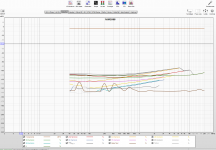 1820m2_2068_bal_IO_DOC1_-3.73dBfs_40Hz-20KHz_all.PNG157.7 KB · Views: 372
1820m2_2068_bal_IO_DOC1_-3.73dBfs_40Hz-20KHz_all.PNG157.7 KB · Views: 372 -
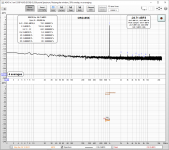 1820m2_1656_bal_IO_DOC1_-24.71dBfs.PNG110.7 KB · Views: 194
1820m2_1656_bal_IO_DOC1_-24.71dBfs.PNG110.7 KB · Views: 194 -
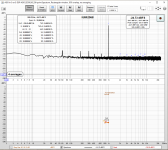 1820m2_2068_bal_IO_DOC1_-24.73dBfs.PNG115 KB · Views: 189
1820m2_2068_bal_IO_DOC1_-24.73dBfs.PNG115 KB · Views: 189 -
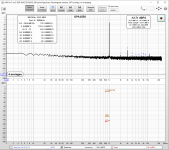 1820m2_1656_bal_IO_DOC1_-12.71dBfs.PNG108.5 KB · Views: 185
1820m2_1656_bal_IO_DOC1_-12.71dBfs.PNG108.5 KB · Views: 185 -
 1820m2_2068_bal_IO_DOC1_-12.73dBfs.PNG120.8 KB · Views: 349
1820m2_2068_bal_IO_DOC1_-12.73dBfs.PNG120.8 KB · Views: 349 -
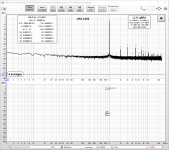 1820m2_1656_bal_IO_DOC1_-3.71dBfs.PNG110.6 KB · Views: 365
1820m2_1656_bal_IO_DOC1_-3.71dBfs.PNG110.6 KB · Views: 365 -
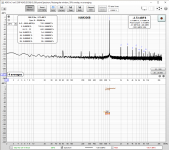 1820m2_2068_bal_IO_DOC1_-3.73dBfs.PNG117.1 KB · Views: 368
1820m2_2068_bal_IO_DOC1_-3.73dBfs.PNG117.1 KB · Views: 368 -
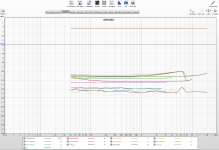 1820m2_1656_bal_IO_DOC1_-4.11dBfs_40Hz-20KHz_all.PNG136.8 KB · Views: 365
1820m2_1656_bal_IO_DOC1_-4.11dBfs_40Hz-20KHz_all.PNG136.8 KB · Views: 365
Last edited:
Also my E-MU 1616m is basically a little oven (half rack) with two PCB face to face with very little useful ventilation. So maybe OPA1678 is a suitable experiment for the E-MU.
Concerning the heat issue, since I have both a stock and a retrofitted 1820m, I can offer this "guestimate":
The one with LM4562 runs noticeably warmer than the stock one, but sans actually trying to get internal air temp measurements, can say the case feels probably 5-10 degrees F warmer. And now I know those opamps are drawing ~14ma quiescent current. I also know the OPA1656 is drawing a little more than half that. So IMO its safe to assume the box when fully retrofitted will run "a little" warmer than the stock one. LOL, hardly scientific but perhaps practical enough to help you decide. Bottom line is I think the other stuff in there is using most of the thermal budget. Certainly don't want to pile on, but IMO given the SQ of the OPA1656 I think its a good upgrade.
Heat is like current and temperature is like voltage. Ambient is "ground" reference temperature.
Whatever difference in temperature rise the case shows above ambient temperature before and after, the chips will show a propoortional difference in temperature rise.
Whatever difference in temperature rise the case shows above ambient temperature before and after, the chips will show a propoortional difference in temperature rise.
Charts for full spectrum and for various output levels @1KHz. Note the distortion peaks below 1KHz on the NJM2068:
Those are mains related peaks (60Hz multiples). It would suggest that OPA1656 has much better PSRR. OTOH the THD numbers are quite close which in turn may suggest that ADC is the limiting factor.
What I have found annoying regarding AKM ADCs is the relatively high 3rd HD. This is especially pronounced at higher frequencies (10kHz or 20kHz). I wonder if there is a cure for this.
Last edited:
Those are mains related peaks (60Hz multiples). It would suggest that OPA1656 has much better PSRR. OTOH the THD numbers are quite close which in turn may suggest that ADC is the limiting factor.
What I have found annoying regarding AKM ADCs is the relatively high 3rd HD. This is especially pronounced at higher frequencies (10kHz or 20kHz). I wonder if there is a cure for this.
The 60Hz et.al. turned out to be coming from my headphone amp with internal PS that is sitting right on top the 1820m. It was on when I tested the 2068 and off for 1656.
As for the AK5394, they seem to be the bottleneck in the loopback. The charts for -.1dBfs which is where a lot of rock and pop material spend considerable time, shows significant increase in distortion for both 2068 and 1656 though the latter is better. Given the 1820m is known to have at least 3dB headroom beyond 0dBfs in its DACs it seems the 5394 is the bottleneck. I'll try to rig a test to drive -.1 out and pad the input and confirm the theory. Hopefully its right since 5394 is known for great sounding recordings and nobody in their right mind is going to set up a session driving the inputs that hard no matter what the source/style.
First chart is 2068, second and third are 1656:
Attachments
When I did my CS4398 filter op-amp experiment with NE5532P, LM4562NA and OPA2134 I found that I could improve the 2nd harmonic but the 3rd harmonic was basically fixed. That 3rd harmonic might be the AK5394 that was doing the measurements, not sure. All three measured very close for noise too.
Later I will try to improve the experiments with the Hall notch filter.
Later I will try to improve the experiments with the Hall notch filter.
If you can increase H2 over H3 you can mask some of the sharpness of the H3. Of course THD will increase........
"If you can increase H2 over H3 you can mask some of the sharpness of the H3."
How the hell, EXACTLY, do you do THAT?
How the hell, EXACTLY, do you do THAT?
Even k2 and k3 will cause imd. Which is highly unmusical. The statement might be somewhat true for minimal mixes like girl and guitar. Most certainly not for anything more complex. IMHO.
"If you can increase H2 over H3 you can mask some of the sharpness of the H3."
How the hell, EXACTLY, do you do THAT?
These are I/V converters on differential DACs, right? You would have to introduce the tiniest amount of non-linearity in just one of the op-amps but not the other. The idea seems sketchy.
My 1616m loopbacks were best around -10 dBFS from the DAC. (REW generator set for -10 dBFS.)
So you replaced all the op-amps, inputs and outputs? Did you recap the 1820m first?
So you replaced all the op-amps, inputs and outputs? Did you recap the 1820m first?
If you can increase H2 over H3 you can mask some of the sharpness of the H3. Of course THD will increase........
By 3rd HD being annoying I actually referred to using AK5394 (in E-MU 1212m) for measurements so increasing H2 is not an option. As it stands my 1212m is quite useless for measuring low distortion amps over 10kHz. What I find strange is that my older M-Audio ProFire 610 with lowly AK5386 ADCs measures much better at 20kHz (see here).
If you can increase H2 over H3 you can mask some of the sharpness of the H3. Of course THD will increase........
I can't imagine that low order distortion (both H2 and H3) sounding unmusical - check out image 4+5 in post #2Even k2 and k3 will cause imd. Which is highly unmusical. The statement might be somewhat true for minimal mixes like girl and guitar. Most certainly not for anything more complex. IMHO.
for me only high order THD components sounding unmusical - check out and compare measurements of test reviews from various models in stereophile mentioned in post #2.
Last edited:
- Home
- Amplifiers
- Solid State
- Choosing of best sounding OP AMPs for the lowest possible THD+N -really the best Way?
